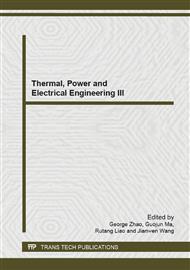[1]
He Yuqing, Peng Jianchun, Wen Ming, Zhou Yangxi, Li Jianying, Li Peng. Minus feasible analysis unit and fast algorithm for distribution network reconfiguration. Proceedings of the CSEE, Vol. 30 (2010), p.50.
Google Scholar
[1]
CIGRE Task Force, Load modeling and dynamics, Electra, vol. 130, pp.124-141, (1990).
Google Scholar
[2]
IEEE Task Force, Load representation for dynamic performance analysis, IEEE Trans. on Power Systems, Vol. 8(1993), p.472.
Google Scholar
[3]
IEEE Task Force, Standard load models for power flow and dynamic performance simulation, IEEE Trans. on Power Systems, Vol. 10(1995), p.1302.
DOI: 10.1109/59.466523
Google Scholar
[4]
Ju Ping, Ma Daqiang, Load modeling of power system (second edition), China Electric Press, (2008).
Google Scholar
[5]
Guo Jinchuan, Yu Yixin, Ni Peng, Zeng Yuan, An improved weighting mean aggregation method of induction motors considering load rates and critical slips, , Automation of Electric Power Systems, Vol. 32(2008. ), pp.6-10.
Google Scholar
[6]
Zhang Jinchao, Zhang Chenxue, Yan Anhe, Zhang Pengfei, Li Kui, Aggregation of multi-induction motors based on the self-organized neural network and steady state model, Automation of Electric Power Systems, Vol. 31(2007), pp.44-48.
Google Scholar
[7]
D.C. Franklin, Amorelato, Improving dynamic aggregation of induction motor models, IEEE Transactions on Power Systems, Vol. 9(1994), p. (1934).
DOI: 10.1109/59.331453
Google Scholar
[8]
M. Akbaba, S.Q. Fakhro, New model for single-unit representation of induction motor loads, including skin effect, for power system transient stability studies, IEE Proceedings-B, Vol. 139(1992), p.521.
DOI: 10.1049/ip-b.1992.0064
Google Scholar
[9]
Zhang Hongbin, Tang Yong, Zhang Dongxia, et al, Equivalent model for induction-motor load connected to high voltage bus, , Proceedings of the CSEE, Vol. 26(2006), pp.1-4.
Google Scholar
[10]
M. Taleb, M. Akbaba, E.A. Abdullah, Aggregation of induction machines for power system dynamic studies, IEEE Transactions on Power systems, Vol. 9(1994), p. (2042).
DOI: 10.1109/59.331467
Google Scholar
[11]
Tang Yong, Hou Junxian, Liu Wenchuo, The modeling of distribution network and var compensator and induction motor in the Load model for power system digital simulation, , Proceedings of the CSEE, Vol. 25(2005), pp.8-12.
Google Scholar
[12]
S. Ahmed-Zaid, M. Taleb, Structural modeling of small and large induction machines using integral manifolds, IEEE Transactions on Energy Conversion, Vol. 6(1991), p.529.
DOI: 10.1109/60.84331
Google Scholar
[13]
Jimnmie J. Cathey, Rglph K. Cavin, A. K. Ayoub, Transient load model of an induction motor, , IEEE Transactions on Power systems and Apparatus, Vol. PAS-92(1973), p.1399.
DOI: 10.1109/tpas.1973.293548
Google Scholar


